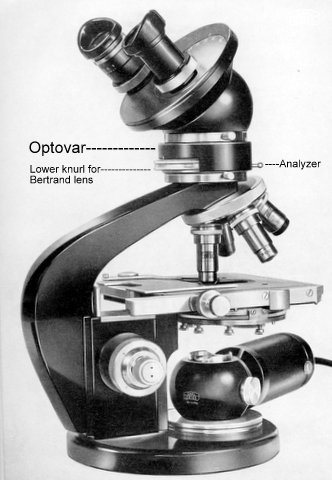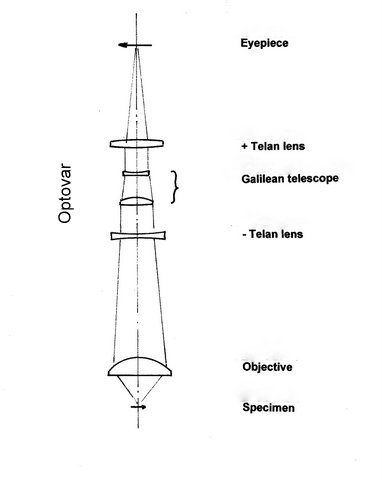
The Carl Zeiss Optovarby Fritz Schulze, Canada |
The Optovar magnification changer was originally introduced by Carl Zeiss Oberkochen / West Germany in 1954 as an accessory to the Stand W. This microscope was the first post-war microscope designed by Dr. Walter Kinder at Oberkochen and incorporated a number of major innovations. As such it deserves a separate essay. What I would like to discuss here is the Optovar magnification changer. Still today it is a much valued accessory to any Zeiss microscope of the Standard series and has, in principle, been incorporated in many newer stands since.
The Optovar is an intermediate tube with a magnification changer, it also features an Amici-Bertrand lens (=auxiliary microscope) and an analyser.
The multi-step magnification changer introduces factors of 1x, 1.6x, and 2.5x .Later versions have the factors 1x, 1.25x, 1.6x, and 2x. The Optovar integrated in the larger Universal, Photomicroscope, and Ultraphot offers the factors 1.25x, 1.6x. and 2x. This allows the microscopist to bridge over the magnification gaps between objectives in small steps and saves him from having to change the eyepieces frequently. The optical systems to achieve this are arranged on a rotatable disc and can be switched in as desired.
For instance, with a standard set of objectives 2.5x, 10x, 40x, and 100x and an eyepiece 8x the following magnifications can be obtained:
20 - (25) - 32 - (40) - 50 - (63) – 80 – (100) – 125 – (160)
200 – (250) –320- (400) – 500 - (630) - 800 – (1000) -1250 -(1600) and
2000x (= the DIN series in steps of 1.6x, steps of 1.25x in brackets – figures are rounded off)
When Leitz started to offer their large-field Orthoplan with considerably increased field numbers, requiring special tubes with larger diameter and corresponding eyepieces in the 1970s, Zeiss responded with the Wide-field Optovar: the factors were reduced by 1.25x and the wide-angle eyepiece magnification correspondingly increased by 1.25x. This resulted in the same magnification and the same large field as the Leitz system but without having to use a special tube and eyepieces!
The Amici-Bertrand lens as it is officially called, together with the eyepiece, forms what is commonly also known as a phase contrast centering telescope or an auxiliary microscope, and is well known to users of polarizing microscopes. It serves to view the rear focal plane (exit pupil) of the objectives. In other words: it shifts the filament plane into the image plane. In the Optovar, the A-B lens is set in a helical mount that can be controlled by a separate wheel so one can focus up and down to reach the rear focal plane of objectives from 16x to 100x. With it the microscopist can see, focus on, and center the phase rings of his phase-contrast system. He can also check the setting of the condenser aperture diaphragm and the correct centering of the filament of the light source.
It is a most useful tool to inspect the optical system for any misalignment, vignetting, dirt in the objective or air bubbles in the oil immersion. With it one can also detect any cracked or damaged lenses, fungus or delamination in the objective. The main convenience is the elimination of having to remove the eyepiece and to insert the auxiliary telescope each time one wants to check the objective’s aperture or the phase rings.
Lastly, the Optovar includes a swing-out analyser or slot to insert one. The biologist needs only to place a polarizer under the condenser to render his instrument into a simple polarizing microscope to examine crystals or other birefringent material.
How was this all achieved?
We all know that the microscopes of the period have a definite tube length of 160mm. Interposing an accessory of 30mm thickness would extend this number to 190mm, affecting to a not inconsiderable extent the optical correction of the image and the parfocalization. In order to avoid this the Optovar has a negative Telan-lens at the bottom which creates an “infinite” light path. The different magnifications are achieved by small Galilean telescopes. Galilean telescopes consist of a positive objective lens and a negative eyepiece lens. They are very short and as such extremely well suited to be installed in a small device such as the Optovar. The light enters from infinity and exits to infinity. A positive Telan-lens of equal power at the upper side of the Optovar recreates again the original condition so that the image is focused on the proper plane in the eyepiece.
Personally I think the Optovar is one of the finest microscope accessories Zeiss has ever invented. I have one on my GFL and one integrated into my Photomicroscope and I use them all the time. Optovars appear rarely on eBay but would be worth the price.
Fritz Schulze
Vineland, ON, Canada
All comments to the author Fritz Schulze are welcomed.
Illustrations

Carl Zeiss Stand W with Optovar attached

Schematic of the optical principle of the Optovar
Carl Zeiss Optovar Magnification Changer Intermediate Tube
View of the Underside of the Optovar
Microscopy UK Front
Page
Micscape
Magazine
Article
Library
Published in the June 2012 edition of Micscape Magazine.
Please report any Web problems or offer general comments to the Micscape Editor .
Micscape is the on-line monthly magazine of the Microscopy UK website at Microscopy-UK .
© Onview.net Ltd, Microscopy-UK, and all contributors 1995 onwards. All rights reserved. Main site is at www.microscopy-uk.org.uk .